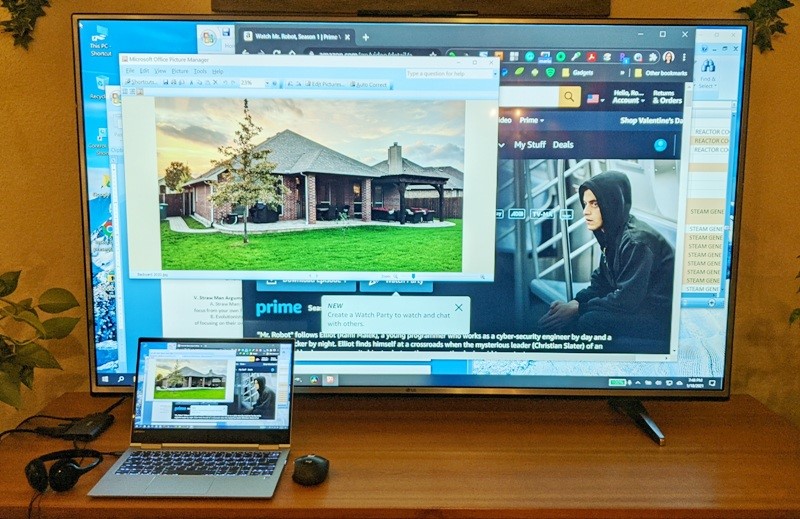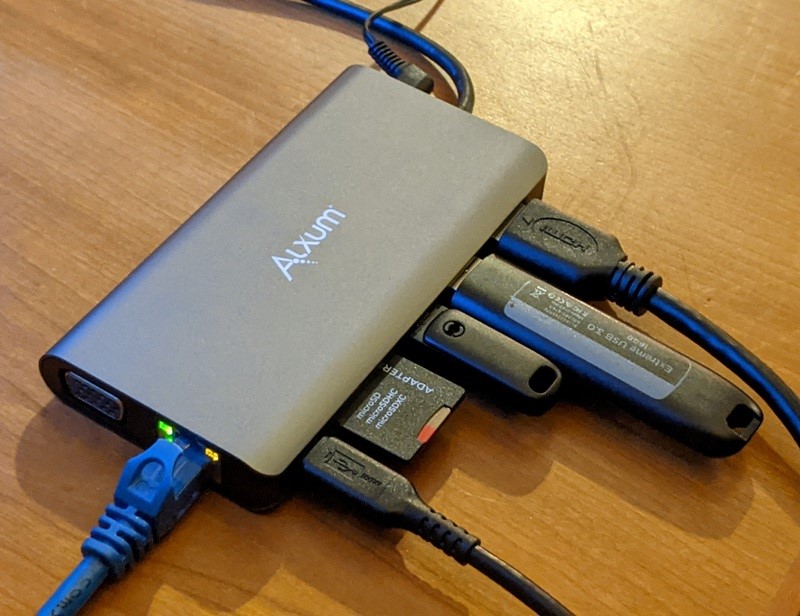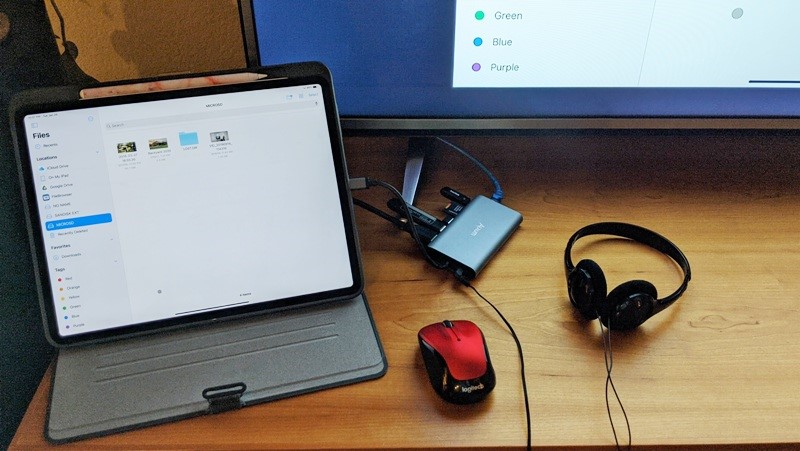Alxum 8-in-1 USB-C hub review
REVIEW – I truly miss having vital ports on my laptop, so I make do with USB-C hubs. Alxum has a few of these hubs, one of which is the 8-in-1 USB-C hub which I was able to review. It has eight ports: an Ethernet port, a VGA port, a USB-C data/100 W Power Delivery 3.0 port, an SD card slot, two USB 3.0 Type-A ports, an HDMI port, and a 3.5 mm audio jack. I was able to test all connections except for the VGA because I don’t have a VGA cable to connect our monitor to the hub (we use the HDMI connection instead). All worked well for me and I liked the flexibility of being able to use the USB-C port to transfer data or charge up to 100 W using the USB-C passthrough charging.
What is it?
The Alxum 8-in-1 USB-C hub is one of those necessary peripherals that allow you to connect eight external devices to your USB-C equipped laptop or tablet. It contains the following ports: Ethernet port, VGA port, USB-C data/100 W Power Delivery 3.0 passthrough charging port, SD card slot, two USB 3.0 (or USB 3.1 Gen 1 or USB 3.2 Gen 1) Type-A ports, HDMI port, and 3.5 mm audio jack.
What’s in the box?
- Alxum 8-in-1 USB-C hub
- User manual
- Thank you card
- (Does not come with a carrying case)
Hardware specs
- Here are the specs for the eight ports according to the Alxum documentation:
-
1-USB-C port supports:
- USB Power Delivery (USB PD) Revision 3.0 Version 1.1 and can charge and connect with multiple peripherals simultaneously
- USB PD Profile 4, maximum power output up to 100 W (20 v/5 A); this USB Type-C hub reserves 5W for its own power consumption
- data transfer rate up to 5 Gbps
-
1-SD Card slot supports:
- data transfer rate up to 480Mbps
-
2-USB 3.0 (USB 3.0 = USB 3.1 Gen 1 = USB 3.2 Gen 1 = confused customers, thanks USB-IF!!) Type-A ports support:
- data transfer rates up to 5 Gbps
- USB 2.0/USB 1.1 (it’s backward compatible with these)
-
1-HDMI port supports:
- HDMI 1.4 output (supports 4K@30Hz resolution)
- HDCP 1.4
-
1-VGA port supports:
- Full HD 1080P resolution
-
1-3.5 mm audio jack supports:
- 48 kHz with a 16-bit sampling rate
-
1-Ethernet RJ45 jack supports:
- 1 Gbps speed
- Wake-on-LAN, half/full-duplex, and power management
- IPv4/IPv6 pack Checksum Offload Engine (COE) to reduce CPU loading
- Serial Peripheral Interface (SPI)
- Plug and play, no driver needed
-
1-USB-C port supports:
-
NOTE – HDMI & VGA Dual Display:
“Supports HDMI 4K 3840×2160@30Hz and VGA 1080P@60Hz. HDMI and VGA output ports can work simultaneously, max resolution 1080P@60Hz. Mirror or extend your screen to HDTVs, monitors, or projectors – up to THREE screens.”
Design and features
 The Alxum 8-in-1 USB-C hub has an outer aluminum housing and is fairly attractive as far as USB-C hubs go. This side of the hub shows (from left to right) the USB-C data/100 W Power Delivery (PD) 3.0, an SD card slot (microSD cards will need an adapter), two USB 3.0 (or USB 3.1 Gen 1 or USB 3.2 Gen 1) Type-A ports, and an HDMI port.
The Alxum 8-in-1 USB-C hub has an outer aluminum housing and is fairly attractive as far as USB-C hubs go. This side of the hub shows (from left to right) the USB-C data/100 W Power Delivery (PD) 3.0, an SD card slot (microSD cards will need an adapter), two USB 3.0 (or USB 3.1 Gen 1 or USB 3.2 Gen 1) Type-A ports, and an HDMI port. 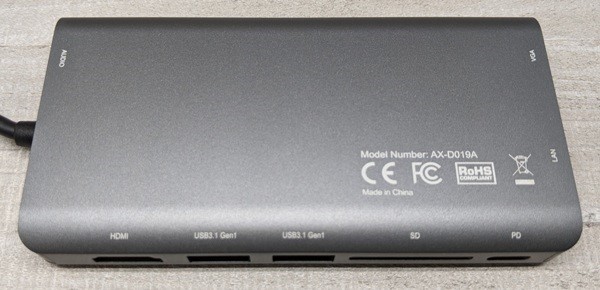 The bottom of the hub has labels for each of the ports.
The bottom of the hub has labels for each of the ports.
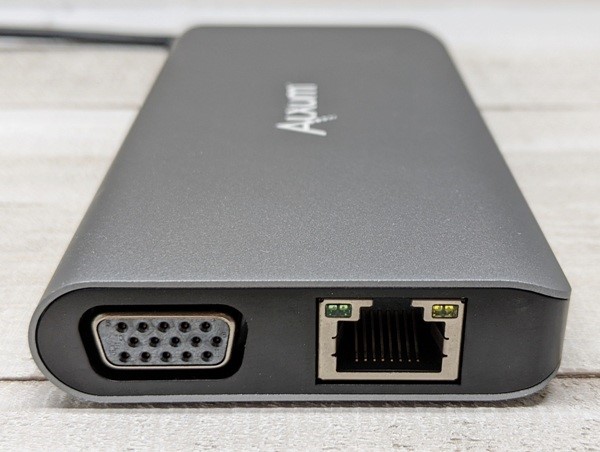
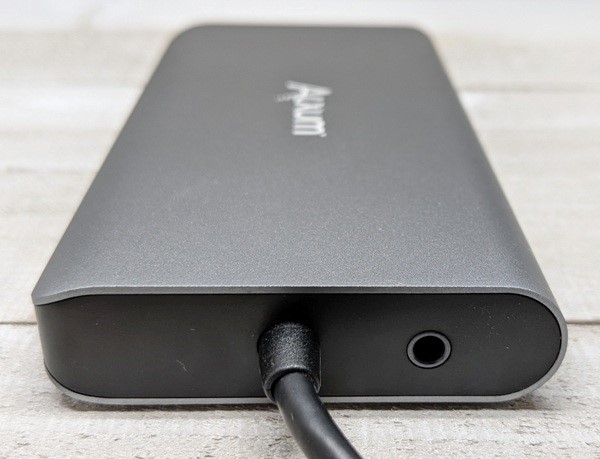
One end of the hub has a VGA port and an Ethernet port with LEDs, while the other end of the hub has a 3.5 mm audio jack.
Performance
I was able to use all of the ports simultaneously (with nothing connected to the VGA port). I connected my Lenovo Yoga 730 13″ laptop to my LG TV using the HDMI port (see “Note” below), I opened a photo on my SD card, I opened a Word document file on one of my USB-A flash drives, I played a video from another USB-A flash drive and listened to it using my headphones that were plugged into the 3.5 mm jack, I used a 65 W wall charger to charge my laptop using the USB-C port, and I searched Amazon using my Ethernet connection. All of them worked well for my purposes.
Note: I was able to mirror my laptop’s screen on our TV as well as extend my laptop’s screen on our TV (mirror screen = same screen, extended screen = additional monitor). To extend your screen, your laptop’s graphics card must support this as well as the hub.
I tried using a USB wireless mouse in one of the USB-A ports and found that it sometimes (not always) stuttered while the other ports were being used.
The above photo shows a close-up view of all my items connected to the USB-C hub.
I also successfully used the Alxum USB-C hub on our 2018 12.9″ iPad Pro. I was able to connect the iPad to my LG TV using the HDMI port, I opened various files on the microSD card and a USB flash drive, I used a USB wireless mouse (the faint grey dot on the iPad screen and TV screen is the mouse cursor), I performed web searches using the Ethernet connection, I used a 90 W charger to charge the iPad using the hub’s USB-C port, and I was able to listen to music through the 3.5 mm audio jack.
Unfortunately, the Alxum USB-C hub did not work with my Pixel 2 XL phone like my Anker PowerExpand+ 7-in-1 USB-C Ethernet Hub and my Aukey Link PD Pro USB-C Hub (or Unity C71 on the Aukey website). However, the Alxum hub does have a USB-C 100 W PD/data port whereas the others do not.
I discovered that while testing the hub using my laptop I lost connection with the USB-A flash drives when I disconnected the wall charger from the hub’s USB-C port. This was easily remedied by disconnecting the hub from my laptop and reconnecting it, but you might want to remember that and not disconnect the charger while you are doing any data transfers from those drives.
You’ll also notice that my USB-A flash drives are upside down. Some people may find the upside-down orientation of the USB-A drives annoying, but it really doesn’t matter much to me.
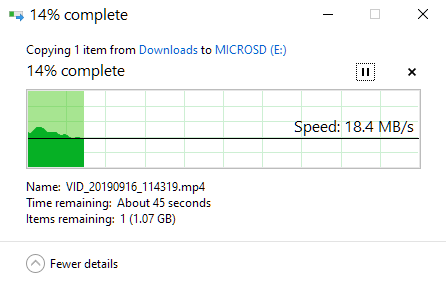
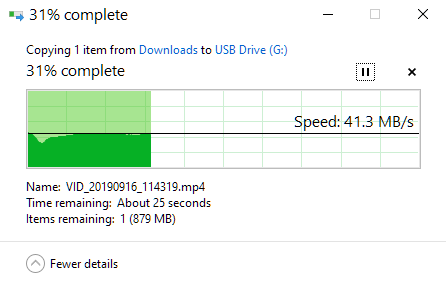
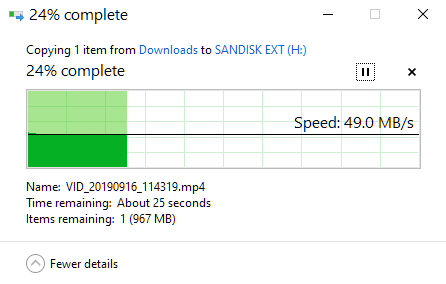
The data transfer rates really depend on both the hub and the capabilities of your storage media. The first screenshot above shows the transfer speed when I copied a large file from my laptop to the microSD card inserted into an SD card adapter on the hub (this was a U1 Class 10 microSD card that had a minimum write speed of 10 MB/sec).
The second and third screenshots above show the transfer speeds from my laptop to my USB 3.0 Type-A flash drives on the hub.
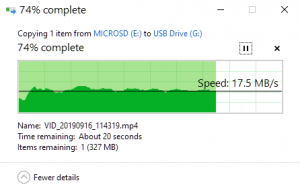
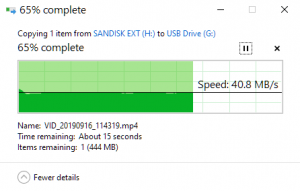
The first screenshot above shows the data transfer speed when copying a file from my microSD card in the hub to the USB 3.0 flash drive in the hub and the second screenshot above shows the transfer speed when copying a file from one USB 3.0 flash drive in the hub to another.

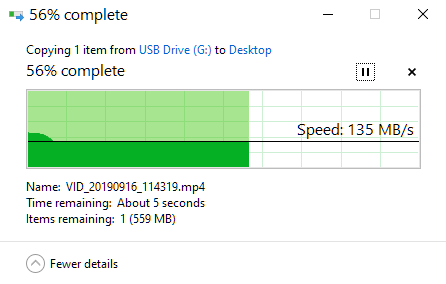
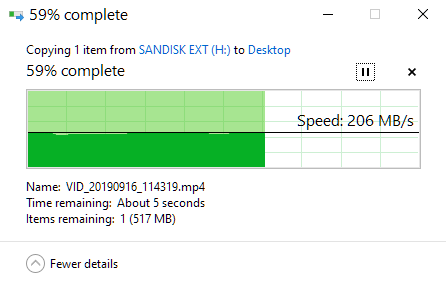
The screenshots above show the data transfer speeds when copying a file from the microSD card in the hub to the laptop (first screenshot), the USB 3.0 flash drive in the hub to the laptop (second screenshot), and the other USB 3.0 flash drive in the hub (SanDisk Extreme CZ80 16GB USB 3.0 Flash Drive – SDCZ80-016G-GAM46) to the laptop (last screenshot) – I love that flash drive, it’s so fast!
What I like
- It has all the ports I need:
- Ethernet port (1Gbps)
- USB-C data/100 W Power Delivery 3.0 port
- SD card slot (microSD cards need an SD card adapter)
- two USB 3.0 ( or USB 3.1 Gen 1 or USB 3.2 Gen 1) Type-A ports
- HDMI port
- 3.5 mm audio jack
- VGA port
- All the ports worked well for me (I was unable to test the VGA port for lack of a VGA cable)
- The USB-C port can be used for passthrough charging (up to 100 W; the hub uses 5 W) or data transfer (up to 5 Gbps)
- It worked well on our 12.9″ iPad Pro (2018) and my Lenovo Yoga 730 13″ laptop
What I’d change
- I would have liked to be able to use the hub on my Pixel 2 XL phone
- A carrying case would be nice
Final thoughts
I enjoyed using the Alxum 8-in-1 USB-C hub. It has all the ports I need: a VGA port, an Ethernet port, a USB-C data/100 W Power Delivery 3.0 port, an SD card slot (microSD cards need an SD card adapter), two USB 3.0 (or USB 3.1 Gen 1 or USB 3.2 Gen 1) Type-A ports, an HDMI port, and a 3.5 mm audio jack. All of the ports worked well for me on my Lenovo Yoga 730 laptop and our 2018 12.9″ iPad Pro (note: I was unable to test the VGA port because I don’t have a cable to test it).
There are a few things to note about the Alxum 8-in-1 USB-C hub. If I had storage media inserted into the hub’s ports and I disconnected the charging cable from the USB-C port, this resulted in losing connection to the USB-A flash drives. This was easily addressed by disconnecting and reconnecting the USB-C hub to my laptop. I also noticed that when using a USB wireless mouse while using the other ports on the hub resulted in some interference (the mouse stuttered) but only periodically. And last, the hub didn’t work with my Pixel 2 XL phone like the Anker PowerExpand+ 7-in-1 USB-C Ethernet Hub or the Aukey Link PD Pro USB-C Hub did.
All-in-all, it’s a nice hub. The USB-C port can be used as a data port or a pass-through charging port (up to 100 W minus the 5 W that the hub needs to power itself), but the other USB-C hubs that I have were cheaper than this one, thus, I might suggest waiting until the price drops before purchasing it.
Price: $48.64
Where to buy: Alxum and Amazon
Source: The sample of this product was provided by Alxum.
Filed in categories: Reviews
Tagged: USB hub
Alxum 8-in-1 USB-C hub review originally appeared on The Gadgeteer on February 12, 2021 at 9:00 am.
Note: If you are subscribed to this feed through FeedBurner, please switch to our native feed URL http://the-gadgeteer.com/feed/ in order to ensure continuous delivery.




